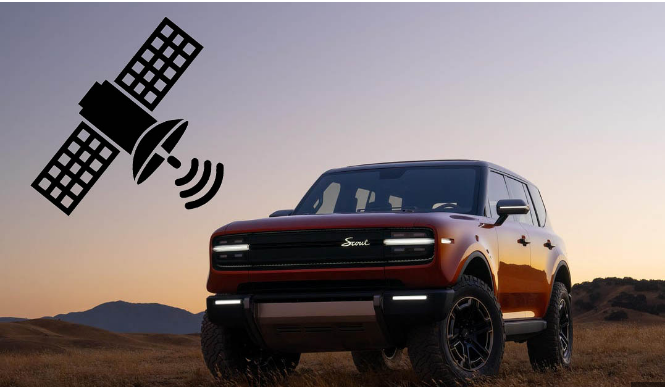
Volkswagen offshoot Scout Motors is getting a jump-start on CES 2025 next week, with some good news for people who plan to take the company’s EVs way, way outdoors: The forthcoming Traveler SUV and Terra pickup will have a built-in satellite connection.
Scout Motors isn’t saying where it’s sourcing the satellite linkup hardware from, or who the service provider will be. All it’s saying at the moment is that the vehicles will be “pre-wired from the factory” and that the hotspot is “intended to have broad reach to help drivers and passengers stay connected in and around their vehicle.”
The company only just unveiled its first two vehicles in October, and they’re not due out until 2027, so it’s not terribly surprising that Scout Motors isn’t ready to spill all the beans yet. Perhaps we can glean a few clues when we see the vehicles in person at next week’s show, where Scout Motors also plans to show off its “Community UX” user interface. This — as we learned at TechCrunch Disrupt — will be built on software developed by Rivian’s joint venture with Volkswagen.
Scout Motors, a pioneering electric vehicle (EV) manufacturer, has announced that its upcoming EV models will feature satellite connectivity. This groundbreaking technology will enable Scout Motors’ EVs to stay connected even in areas with limited or no cellular coverage, revolutionizing the electric vehicle industry.
Background: The Need for Reliable Connectivity
As the world becomes increasingly reliant on connected technologies, the need for reliable and ubiquitous connectivity has never been more pressing. Electric vehicles, in particular, require seamless connectivity to enable features like over-the-air updates, remote diagnostics, and real-time navigation.
How Satellite Connectivity Works
Scout Motors’ satellite connectivity system utilizes a network of low-Earth orbit (LEO) satellites to provide global coverage. The system consists of three primary components:
1. Satellite Constellation: A network of LEO satellites orbiting the Earth, providing coverage even in the most remote areas.
2. Vehicle-Mounted Antenna: A compact, high-gain antenna installed on the vehicle, enabling communication with the satellite constellation.
3. Software and Modem: Advanced software and modem technology integrated into the vehicle’s computer system, managing communication with the satellite network and enabling features like data transmission and reception.
Benefits of Satellite Connectivity in Scout Motors EVs
The integration of satellite connectivity in Scout Motors EVs offers numerous benefits, including:
1. Global Coverage: Satellite connectivity provides global coverage, ensuring that Scout Motors EVs remain connected even in areas with limited or no cellular coverage.
2. Reliable Communication: Satellite connectivity enables reliable communication between the vehicle and the cloud, facilitating features like over-the-air updates, remote diagnostics, and real-time navigation.
3. Enhanced Safety and Security: Satellite connectivity enables Scout Motors to remotely monitor and diagnose vehicle issues, ensuring prompt attention and minimizing the risk of accidents or security breaches.
4. Improved Customer Experience: Satellite connectivity enables Scout Motors to provide customers with real-time information, personalized services, and seamless software updates, enhancing the overall ownership experience.
Implications for the Electric Vehicle Industry
The integration of satellite connectivity in Scout Motors EVs has significant implications for the electric vehicle industry, including:
1. New Business Models: Satellite connectivity enables new business models, such as subscription-based services, data analytics, and advertising.
2. Increased Competition: The adoption of satellite connectivity by Scout Motors raises the bar for competitors, driving innovation and investment in connected technologies.
3. Regulatory Frameworks: The integration of satellite connectivity in EVs will require regulatory frameworks to ensure safe and secure operation, driving the development of new standards and guidelines.
Challenges and Limitations
While satellite connectivity offers numerous benefits, there are also challenges and limitations to consider, including:
1. Cost and Complexity: The integration of satellite connectivity requires significant investment in hardware, software, and infrastructure, increasing the complexity and cost of EVs.
2. Signal Interference and Latency: Satellite signals can be affected by interference and latency, impacting the reliability and performance of connected services.
3. Security and Data Protection: The transmission of sensitive data via satellite requires robust security measures to prevent unauthorized access and data breaches.
Conclusion
The integration of satellite connectivity in Scout Motors EVs represents a significant milestone in the electric vehicle industry. By providing global coverage, reliable communication, and enhanced safety and security, satellite connectivity is poised to revolutionize the ownership experience and drive innovation in the industry. As the adoption of satellite connectivity becomes more widespread, we can expect to see new business models, increased competition, and regulatory frameworks emerge, shaping the future of the electric vehicle industry.
The integration of satellite connectivity in Scout Motors EVs offers numerous benefits, transforming the electric vehicle ownership experience and driving innovation in the industry. Here are some of the key advantages:
Benefits for Drivers and Passengers
1. Global Coverage: Satellite connectivity provides global coverage, ensuring that drivers and passengers stay connected even in areas with limited or no cellular coverage.
2. Real-Time Navigation: Satellite connectivity enables real-time navigation, providing drivers with up-to-date traffic information, route optimization, and turn-by-turn directions.
3. Emergency Services: Satellite connectivity enables emergency services, such as roadside assistance, crash detection, and emergency calling, ensuring drivers receive prompt assistance in critical situations.
4. Infotainment and Entertainment: Satellite connectivity enables seamless infotainment and entertainment experiences, providing drivers and passengers with access to streaming services, music, and podcasts.
Benefits for Vehicle Owners and Operators
1. Remote Diagnostics and Maintenance: Satellite connectivity enables remote diagnostics and maintenance, allowing owners and operators to monitor vehicle health, receive maintenance alerts, and perform software updates remotely.
2. Vehicle Tracking and Security: Satellite connectivity enables vehicle tracking and security features, such as stolen vehicle recovery, geofencing, and immobilization, providing owners and operators with peace of mind.
3. Over-the-Air Updates: Satellite connectivity enables over-the-air updates, allowing owners and operators to receive software updates, security patches, and feature enhancements without the need for physical visits to dealerships or service centers.
4. Data Analytics and Insights: Satellite connectivity enables data analytics and insights, providing owners and operators with valuable information on vehicle performance, usage patterns, and maintenance needs.
Benefits for the Environment and Society
1. Reduced Emissions: Satellite connectivity can help reduce emissions by optimizing routes, improving fuel efficiency, and enabling electric vehicle owners to charge their vehicles during off-peak hours.
2. Improved Road Safety: Satellite connectivity can improve road safety by enabling features like automatic emergency calling, crash detection, and driver assistance systems.
3. Enhanced Mobility and Accessibility: Satellite connectivity can enhance mobility and accessibility for people with disabilities, elderly individuals, and those living in rural or underserved areas.
4. Support for Smart Cities and Infrastructure: Satellite connectivity can support the development of smart cities and infrastructure, enabling the creation of intelligent transportation systems, smart grids, and other urban infrastructure.
Benefits for the Electric Vehicle Industry
1. Increased Adoption and Growth: Satellite connectivity can increase adoption and growth of electric vehicles by providing drivers with a seamless and connected experience.
2. Competitive Advantage: Satellite connectivity can provide electric vehicle manufacturers with a competitive advantage, differentiating their products and services from those of competitors.
3. New Business Models and Revenue Streams: Satellite connectivity can enable new business models and revenue streams for electric vehicle manufacturers, such as subscription-based services, data analytics, and advertising.
4. Improved Customer Experience and Satisfaction: Satellite connectivity can improve customer experience and satisfaction, leading to increased loyalty and retention, and positive word-of-mouth and reviews.
Conclusion
The integration of satellite connectivity in Scout Motors EVs offers numerous benefits, transforming the electric vehicle ownership experience and driving innovation in the industry. From global coverage and real-time navigation to remote diagnostics and vehicle tracking, satellite connectivity provides a wide range of advantages for drivers, passengers, vehicle owners and operators, and the environment and society.



